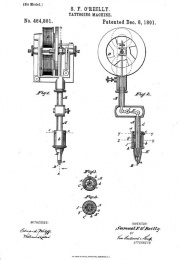Cigarettes and Samuel O'Reilly: Difference between pages
(Difference between pages)
Jump to navigation
Jump to search
(Page conversion via llm-mediawiki-rev -jwm) |
(Page conversion via llm-mediawiki-rev -jwm) |
||
| Line 1: | Line 1: | ||
[[ | '''Samuel O'Reilly''' was a [[Tattoo artist]] from Ireland who filed [[Patent No 464801]] for the electric [[Tattoo machine]]. It was patented in [[1891]]. O'Reilly experimented with Thomas Edison's [[1875]] invention, the electric pen, as a tattooing device. He modified it slightly, adding an ink reservoir and multiple needles, and this became the tattoo machine that he is known for.[http://www.wisconsinhistory.org/wmh/pdf/spring06_klem.pdf [1]] He began tattooing in New York in [[1875]]. O'Reilly was also responsible, along with his apprentice [[Charles Wagner]], for producing a number of tattooed attractions in the late 1800s. He tattooed many people who worked as [[Performers (page does not exist)|performers]] such as Frank and [[Emma de Burgh]], [[Annie Howard]] and [[Irene Woodward]]. | ||
He died in [[1908]] in Brooklyn, New York, falling off of his house while painting. | |||
[[File:O-reilly_patent.jpg|thumb|right|180px|Samuel O'Reilly tattoo machine]] | |||
== See Also == | == See Also == | ||
* [[Patent No 464801]] | |||
* [[ | |||
Latest revision as of 10:50, 17 September 2023
Samuel O'Reilly was a Tattoo artist from Ireland who filed Patent No 464801 for the electric Tattoo machine. It was patented in 1891. O'Reilly experimented with Thomas Edison's 1875 invention, the electric pen, as a tattooing device. He modified it slightly, adding an ink reservoir and multiple needles, and this became the tattoo machine that he is known for.[1] He began tattooing in New York in 1875. O'Reilly was also responsible, along with his apprentice Charles Wagner, for producing a number of tattooed attractions in the late 1800s. He tattooed many people who worked as performers such as Frank and Emma de Burgh, Annie Howard and Irene Woodward.
He died in 1908 in Brooklyn, New York, falling off of his house while painting.
